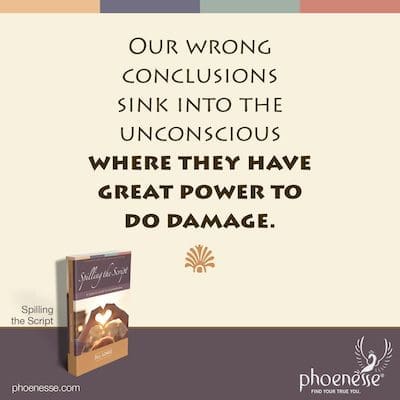
All experiences begin with thoughts, because in thought lies intent. Thoughts and beliefs create feelings, which lead to attitudes and behaviors, and this is what results in life circumstances. So in making changes, we always have to begin with our thoughts. The problem lies in our not actually knowing what we really think and believe.
When we look out over the ocean, we see the waves and the birds and the boats and swimmers and the islands. But for the most part, we cannot see what lies under the surface. It is like that with our thoughts that have gone into our unconscious. They are out of sight, but they are not out of mind.
When a child has a painful experience, it feels like life and death. To avoid death, the child will draw conclusions about life that it believes will help keep it safe. The Guide calls our many wrong conclusions “images.” They are generalizations about life that are primitive, ignorant and illogical, although they follow a certain logic of their own.
As the child grows older, these unconscious thoughts don’t hold up to the light of day. So they sink into the unconscious where they have great power to do damage. For they attract disappointing life experiences that are often the exact opposite from what a person consciously desires. These images are what we need to surface if we want to understand the root of any unfulfilling patterns in our lives.

Images form when a child is quite young. So we make them using a child’s vocabulary. “People want to be mean to me” is an example. This is a generalized conclusion that a child of an aggressive Will Type parent might believe to be true about everyone.
This person then goes through life unconsciously believing that everyone is a potential enemy. Consciously, they just want people to be nice to them. But due to this image, the person will show up defended behind a mask. Then, when the other, due to their own issues—or perhaps in reaction to our presenting them with an impenetrable mask—is unkind, it will feel like the threat of death. This seems to confirm the image and the need for the defense.
This underground dynamic causes a person to go through life in a trance that narrows our perception of reality. Because we are not seeing the whole truth, we interpret life situations erroneously; we think others are being intentionally hurtful, and we react accordingly.
This explains how in our blindness, we continually recreate life experiences that seem to validate our misconceptions. When these beliefs surface, there will be a recognition that says, “Yes, this is what I have always believed was true.” So we are not searching for some idea that will seem completely foreign to us. Yet, until we surface it, it will remain just beyond our grasp.
Learn more in Bones, Chapter 9: Images and the Deep, Deep Damage They Do, and in Suffering? Here’s Why. Better Yet, Here’s How to Resolve It.

Images create an inflexible, rigid mass in the soul substance that will stay with us until we begin to do this work of self-understanding. Only by surfacing all of this can we see how our unconscious desires conflict with what we think we want.
So why wouldn’t we all immediately dive in and discover what lurks below the waterline? Pride—that’s what stops us. We don’t want to be wrong, because in the dualistic way of thinking, being wrong is bad. And for the child, that seems to confirm being worthless.
Surprisingly, just seeing these hidden beliefs does not stop them from operating. We need to be willing to feel the associated buried feelings so we can stop defending against the threat of pain. And we need to employ our healthy ego to access our inner self to find the truth of the matter.
Then we can begin the gradual process of re-educating and maturing the inner child: “It is not true that people intend to be mean to me. Sometimes they lash out due to their own issues, but this does not mean that they are personally out to get me. I can use my communication skills to ask questions and seek to understand the other.”
The Prayer of Saint Francis
Lord, make me an instrument of thy peace.
Where there is hatred, let me sow love;
And where there is injury, pardon;
Where there is doubt, faith;
And where there is despair, hope;
Where there is darkness, light;
And where there is sadness, joy.
O divine Master, grant that I may not so much seek
To be consoled as to console,
To be understood as to understand,
And to be loved as to love;
For it is in giving that we receive;
It is in pardoning that we are pardoned;
It is in dying to self that we are born to eternal life.

Our Lower Self wants to always have its way, without ever having to pay any price for this. It is a spiritual law, however, that to have what we want in life, there is a price we must be willing to pay. The price is self-confrontation. Alternatively, living a life in which emotional reactions or negative patterns of behavior repeatedly happen is the price we pay for our beliefs that go against truth.
The spiritual Law of Brotherhood says we don’t have to do this work alone. And that we will receive more help when we reach out to another. To see our own blindness, we often need the patience, skill and guiding hand of someone else—perhaps a therapist or a trained spiritual healer—who can help hold the flashlight while we look into these hidden inner spaces.
Origin of an Image | A Process of Four Steps
1. Childhood hurts cause unhappiness and discontent, and the child wants to avoid pain.
2. Child concludes that each similar situation to the one that caused the hurt will bring similar pain. So what was once a reality has now turned into an illusion because the generalization is false.
3. The generalization freezes into a rigid preconceived idea. This is the image: a frozen wrong conception, an inflexible, rigid mass in the soul substance, which attracts situations to justify its continued existence.
4. As the image is unreal, so must be the “remedy” or pseudo-solution which is adopted. Because it is unrealistic, the results are disappointing, often producing the exact opposite from what is desired. So the circumstances continue to be produced.
Dismantling an Image | A Process of Four Steps
1. Find the statement of the image, and write it out in black and white. For example: I don’t matter; I am worthless; I cause other people pain; People will always be mean to me; Nobody likes me; I have to prove myself; I’m not enough and I will never be enough.
2. Connect with the willingness to consciously find the original event where the pain was felt. Feel that old pain by letting go of the pride which prevents the experience of feeling the hurt.
3. Be willing to challenge the original conclusion and see what the right conclusion could be.
4. Pray for the truth to be revealed. Allow the new conclusion to be planted in the newly alive soil of our opened feelings.
Learn more in Healing the Hurt: How to Help Using Spiritual Guidance, and Healing by Opening Up: Why Do We Tell Our Stories?
Return to Spilling the Script Contents



